-
 Ronald Joseph Ryan was hanged in Melbourne on February 3, 1967, following his conviction for the shooting murder of a prison warder during a daring escape from the maximum-security Pentridge prison thirteen months before. The decision of the Victorian government in December 1966 to proceed with Ryan’s death sentence sparked immediate media condemnation and angry political protests, and put the Liberal premier, Sir Henry Bolte, under siege for the duration of the case. State governments around the country moved to abolish the death penalty in the 1970s and 1980s, and Ronald Ryan became the last man to be hanged in Australia. But who was Ronald Ryan, and how did he come to be the focus of such dramatic political events? Drawing on previously unpublished documents and personal accounts — including details of Ryan’s childhood and his early turn to crime — this book reveals the truth about Ryan’s guilt. It also goes behind the scenes to tell for the first time of the life-long anguish of the judge who pronounced the death sentence, the inner workings of the secret cabinet meeting that decided Ryan’s fate, and the dramatic political process that resulted in the rejection of eleventh-hour appeals to save Ryan. Illustrated with black and white photographs.
Ronald Joseph Ryan was hanged in Melbourne on February 3, 1967, following his conviction for the shooting murder of a prison warder during a daring escape from the maximum-security Pentridge prison thirteen months before. The decision of the Victorian government in December 1966 to proceed with Ryan’s death sentence sparked immediate media condemnation and angry political protests, and put the Liberal premier, Sir Henry Bolte, under siege for the duration of the case. State governments around the country moved to abolish the death penalty in the 1970s and 1980s, and Ronald Ryan became the last man to be hanged in Australia. But who was Ronald Ryan, and how did he come to be the focus of such dramatic political events? Drawing on previously unpublished documents and personal accounts — including details of Ryan’s childhood and his early turn to crime — this book reveals the truth about Ryan’s guilt. It also goes behind the scenes to tell for the first time of the life-long anguish of the judge who pronounced the death sentence, the inner workings of the secret cabinet meeting that decided Ryan’s fate, and the dramatic political process that resulted in the rejection of eleventh-hour appeals to save Ryan. Illustrated with black and white photographs. -
 Australia has had its fair share of murders - the grisly, the macabre, the humdrum, the unsolved and the controversial. Men have been hanged who perhaps should never have been convicted; men have gone free who perhaps should have been found guilty. Just the chapter headings alone are enough to entice the reader: The Crimson Feather; Roadside Nightmare - the murder of a courting couple by William Moxley; The Pyjama Girl case, still unsolved to this day; The Walking Corpse ( dubbed the 'Mutilator Murders') and more.
Australia has had its fair share of murders - the grisly, the macabre, the humdrum, the unsolved and the controversial. Men have been hanged who perhaps should never have been convicted; men have gone free who perhaps should have been found guilty. Just the chapter headings alone are enough to entice the reader: The Crimson Feather; Roadside Nightmare - the murder of a courting couple by William Moxley; The Pyjama Girl case, still unsolved to this day; The Walking Corpse ( dubbed the 'Mutilator Murders') and more. -
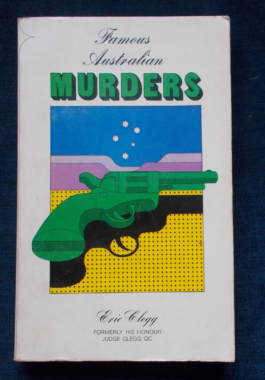 Eric Clegg, formerly His Honour Eric Clegg Q.C. is more than qualified to examine these famous trials and his expert viewpoint reveals many important and often controversial points which arose during the hearings. Cases contained in this volume include: The Kalgoorlie murders of two policemen in 1926, found down a disused mine-shaft; the Passionate Parson, acquitted on a charge of murdering his wife; the Lavers mstyery and the Sundown murders; the Pyjama Girl murder; the fantastic case of T. J. Ley, former Minister for Justice in New South Wales who was eventually convicted for the chalkpit murders and more. Illustrated with black and white photographs.
Eric Clegg, formerly His Honour Eric Clegg Q.C. is more than qualified to examine these famous trials and his expert viewpoint reveals many important and often controversial points which arose during the hearings. Cases contained in this volume include: The Kalgoorlie murders of two policemen in 1926, found down a disused mine-shaft; the Passionate Parson, acquitted on a charge of murdering his wife; the Lavers mstyery and the Sundown murders; the Pyjama Girl murder; the fantastic case of T. J. Ley, former Minister for Justice in New South Wales who was eventually convicted for the chalkpit murders and more. Illustrated with black and white photographs. -
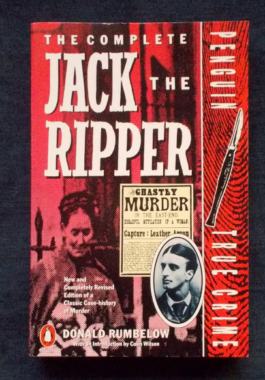 With the advantage of access to some of Scotland Yard's most confidential papers, Donald Rumbelow lays out all the evidence in the most comprehensive summary ever written about the Ripper. Rumbelow, a former London Metropolitan policeman, and an authority on crime, has subjected every theory – including those that have emerged in recent years – to the same deep scrutiny. He also examines the mythology surrounding the case and provides some fascinating insights into the portrayal of the Ripper on stage and screen and on the printed page. More seriously, he also examines the horrifying parallel crimes of the Düsseldorf Ripper and the Yorkshire Ripper in an attempt to throw further light on the atrocities of Victorian London.
With the advantage of access to some of Scotland Yard's most confidential papers, Donald Rumbelow lays out all the evidence in the most comprehensive summary ever written about the Ripper. Rumbelow, a former London Metropolitan policeman, and an authority on crime, has subjected every theory – including those that have emerged in recent years – to the same deep scrutiny. He also examines the mythology surrounding the case and provides some fascinating insights into the portrayal of the Ripper on stage and screen and on the printed page. More seriously, he also examines the horrifying parallel crimes of the Düsseldorf Ripper and the Yorkshire Ripper in an attempt to throw further light on the atrocities of Victorian London. -
 The author took a job in an Australian prison because - well, he needed a job, and any job would do. What had been a stop gap became and all-absorbing preoccupation with the problem of men in prison. One day, he was asked if he remembered the Greek bloke who had killed his wife with half a house brick. He couldn't remember the particular Greek - and he realised that over the seven years of his employment there, that the stone and steel had crept into his heart to the extent that a man who had killed his wife with half a house brick had left no impression on him. In search of what beliefs and values he had left to him after prolonged exposure to the brutality, cynicism and despair of a big maximum-security prison, the author examines his experiences, not as a psychologist, but as a man whose profession is psychology. In the process, comes to several important conclusions.
The author took a job in an Australian prison because - well, he needed a job, and any job would do. What had been a stop gap became and all-absorbing preoccupation with the problem of men in prison. One day, he was asked if he remembered the Greek bloke who had killed his wife with half a house brick. He couldn't remember the particular Greek - and he realised that over the seven years of his employment there, that the stone and steel had crept into his heart to the extent that a man who had killed his wife with half a house brick had left no impression on him. In search of what beliefs and values he had left to him after prolonged exposure to the brutality, cynicism and despair of a big maximum-security prison, the author examines his experiences, not as a psychologist, but as a man whose profession is psychology. In the process, comes to several important conclusions. -
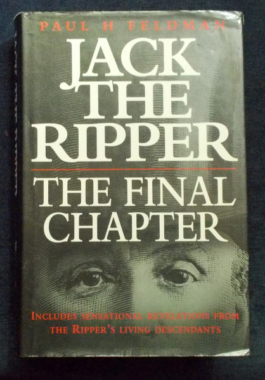 Feldman makes a convincing case for his suspect. His team spent a great deal of time, money and effort following leads in obscure documents, some of which had never been seen by anyone, to conclusively prove his theory. Illegitimate children, extra-marital affairs, high society, royal connections and a mysterious diary and a watch are just some of what came to light. Illustrated with black and white photographs.
Feldman makes a convincing case for his suspect. His team spent a great deal of time, money and effort following leads in obscure documents, some of which had never been seen by anyone, to conclusively prove his theory. Illegitimate children, extra-marital affairs, high society, royal connections and a mysterious diary and a watch are just some of what came to light. Illustrated with black and white photographs. -
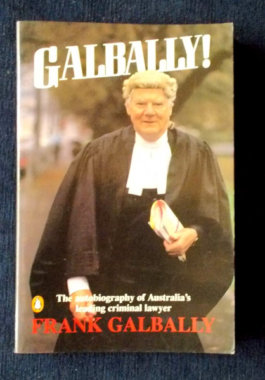
Galbally! Frank Galbally
$9.00Frank Galbally CBE (1922 - 2005) dominated Australian Law for over four decades, frequently at the centre of controversy and always at the heart of things. He represented everyone from painters and dockers to a talking cockatoo; had audiences with popes and took on the Greek Colonels and was embroiled in the politics of 1975 and the policies of Collingwood Football Club. The Krope trial, the Costigan Commission, Kevin Barlow's appeal...the number of legal trials in which Galbally was involved extraordinary and the names became household words. This autobiography contains some of his most famous cases, with a few fighting words regarding crucial aspects of Australian public affairs such as police corruption and the royal commission into crime. Illustrated with black and white photographs. -
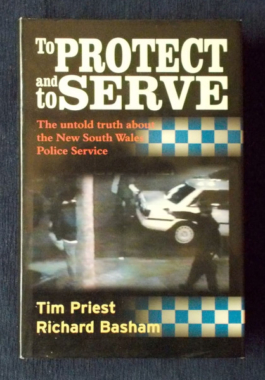 Almost every month in New South Wales, there are reports of police corruption and a police service under attack, from the criminals it tries to put away and the people it tries to protect and serve. Are the reports mere media sensationalism, or is the New South Wales Police in serious trouble? And if so, where did it go wrong? Priest was a cop who loved his job and gave everything he had to fight crime on the drug-ridden streets of Cabramatta. Yet he found his biggest battle was not with the drug gangs but with the very service he worked for. Eventually he could stand it no longer and spoke out about the bizarre policy decisions, politics, bureaucratic bungling and chronic lack of resources. For this he was labelled a whistle-blower and ultimately railroaded out of the police force. Yet a parlimentary enquiry and the testimony of other officers proved that Tim was not only telling the truth, but this was only the tip of the iceberg of what is really wrong with the New South Wales Police Force. While crime continues to spiral out of control, morale plummets among the rank and file police and experienced cops find they are at the mercy of a promotion system that leaves them nowhere to go but out. Tim teams up with Richard Basham, a man of vast experience through his involvement in a number of advisory boards, criminal investigations and personal friendships with ordinary cops, to reveal the untold story of the police service.
Almost every month in New South Wales, there are reports of police corruption and a police service under attack, from the criminals it tries to put away and the people it tries to protect and serve. Are the reports mere media sensationalism, or is the New South Wales Police in serious trouble? And if so, where did it go wrong? Priest was a cop who loved his job and gave everything he had to fight crime on the drug-ridden streets of Cabramatta. Yet he found his biggest battle was not with the drug gangs but with the very service he worked for. Eventually he could stand it no longer and spoke out about the bizarre policy decisions, politics, bureaucratic bungling and chronic lack of resources. For this he was labelled a whistle-blower and ultimately railroaded out of the police force. Yet a parlimentary enquiry and the testimony of other officers proved that Tim was not only telling the truth, but this was only the tip of the iceberg of what is really wrong with the New South Wales Police Force. While crime continues to spiral out of control, morale plummets among the rank and file police and experienced cops find they are at the mercy of a promotion system that leaves them nowhere to go but out. Tim teams up with Richard Basham, a man of vast experience through his involvement in a number of advisory boards, criminal investigations and personal friendships with ordinary cops, to reveal the untold story of the police service. -

Blood Stain: Peter Lalor
$15.00On 29 February 2000, Katherine Knight - mother of four, and a grandmother - seduced then stabbed John Price 37 times. A former abattoir worker, she skinned him. A loving partner, she cooked him with vegetables, making a soup with his head. She made gravy, and left him on plates for his family...Price was her de facto, and he wanted out. And Ketharine didn't like that...People said that most of the time Katherine seemed normal - until she got angry. She was judged to be legally sane when she committed a crime so horrible the media shied away from the details. Lalor covered the trial and wanted to know what made Knight go way over the borderline. He uncovers the layers of her dysfunction, opens the door of 84 St. Andrews Street and heads into the lives of Knight's ex-partners, her family and the locals of Aberdeen, New South Wales. Illustrated with colour photographs.


